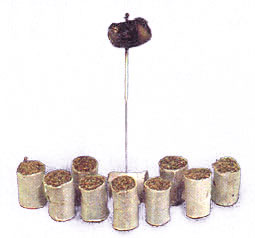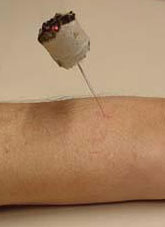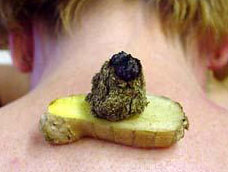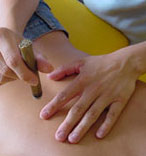
Patient Information Center
Articles




Patient Information Center... Additional Chinese Modalities
What is Moxibustion?
 Moxibustion
is a traditional Chinese medicine technique that involves the burning of
mugwort, a small, spongy herb, to facilitate healing. Moxibustion has been
used throughout Asia for thousands of years; in fact, the actual Chinese
character for acupuncture, translated literally, means
"acupuncture-moxibustion." The purpose of moxibustion, as with most forms of
traditional Chinese medicine, is to strengthen the blood, stimulate the flow
of qi, and maintain general health.
Moxibustion
is a traditional Chinese medicine technique that involves the burning of
mugwort, a small, spongy herb, to facilitate healing. Moxibustion has been
used throughout Asia for thousands of years; in fact, the actual Chinese
character for acupuncture, translated literally, means
"acupuncture-moxibustion." The purpose of moxibustion, as with most forms of
traditional Chinese medicine, is to strengthen the blood, stimulate the flow
of qi, and maintain general health.
There are two types of moxibustion: direct and indirect
Direct moxibustion a small, cone-shaped amount of moxa is placed on top of an acupuncture point and burned. This type of moxibustion is further categorized into two types: scarring and non-scarring. With scarring moxibustion, the moxa is placed on a point, ignited, and allowed to remain onto the point until it burns out completely. This may lead to localized scarring, blisters and scarring after healing. With non-scarring moxibustion, the moxa is placed on the point and lit, but is extinguished or removed before it burns the skin.
The patient will experience a pleasant heating sensation that penetrates deep into the skin, but should not experience any pain, blistering or scarring unless the moxa is left in place for too long.

Indirect moxibustion is currently the more popular form of care because there is a much lower risk of pain or burning. In indirect moxibustion, a practitioner lights one end of a moxa stick, roughly the shape and size of a cigar, and holds it close to the area being treated for several minutes until the area turns red. Another form of indirect moxibustion uses both acupuncture needles and moxa. A needle is inserted into an acupoint and retained. The tip of the needle is then wrapped in moxa and ignited, generating heat to the point and the surrounding area. After the desired effect is achieved, the moxa is extinguished and the needle(s) removed.

 Indirect Moxa Applied
Indirect Moxa Applied
What is moxibustion used for?
In traditional Chinese medicine, moxibustion is used on people who have a cold or stagnant condition. The burning of moxa is believed to expel cold and warm the meridians, which leads to smoother flow of blood and qi. In Western medicine, moxibustion has successfully been used to turn breech babies into a normal head-down position prior to childbirth. A landmark study published in the Journal of the American Medical Association in 1998 found that up to 75% of women suffering from breech presentations before childbirth had fetuses that rotated to the normal position after receiving moxibustion at an acupuncture point on the Bladder meridian. Other studies have shown that moxibustion increases the movement of the fetus in pregnant women, and may reduce the symptoms of menstrual cramps when used in conjunction with traditional acupuncture.
Why do acupuncturists use mugwort? Why not use some other herb?

Mugwort, also known as artemesia vulgaris or ai ye in Chinese, has a long history of use in folk medicine. Research has shown that it acts as an emmenagogue  that is, an agent that increases blood circulation to the pelvic area and uterus and stimulates menstruation. This could explain its use in treating breech births and menstrual cramps.
Are there any precautions I should be aware of?
Although moxibustion has been safely used in traditional Chinese medicine for centuries, it is not for everyone. Because it is used specifically for patients suffering from cold or stagnant constitutions, it should not be used on anyone diagnosed with too much heat. Burning moxa also produces a great deal of smoke and a pungent odor. Patients with respiratory problems may request that their practitioner use smokeless moxa sticks as an alternative.
Direct moxa, indirect moxa, and needle moxa should
always be administered and used under the direction or supervision of a
qualified practitioner.
Do not leave patient unattended during any moxa use.
Do not use moxa on the face, soft skin, or other sensitive body areas.
Do not use moxa on infants or young children. Do not use moxa on
patients who are not able to detect the sensations of heat or pain (i.e.
elderly, patients with nerve damage, etc).
When using needle moxa, a protective shield, (i.e. aluminum foil), must
be placed under and around the needle to protect the skin from loose or
falling moxa ash.
When using moxa rolls, the burned ash must be frequently removed by
gently tapping the side of the roll against a suitable container. For
patient safety, do not use moxa rolls or any moxa product if damaged or
cracked.
Always ignite stick-on moxa first and then apply to the point. If heat
becomes uncomfortable, remove or move moxa to another location. If used
incorrectly, redness or a small heat blister may appear after
application.